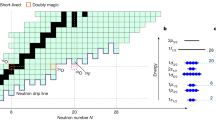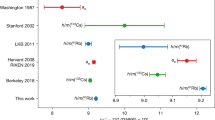Abstract
A NUMBER of recent papers1–6 have dealt with the values of the Einstein A coefficients describing spontaneous emission for the hyperfine split 2π3/2, J=3/2, Λ-doublet transition in OH. These values are important in connexion with determinations of the interstellar abundance of OH and the non-Boltzmann population of the hyperfine levels. At least four different sets of calculated values have been presented. All previous authors, however, have attacked the problem by the methods outlined in the books of Condon and Shortley7 and Townes and Schawlow8. Because these methods involve complicated algebraic manipulation and, moreover, a pertinent matrix element listed by Townes and Schawlow has been shown to be incorrect, we decided to approach the problem differently, using Racah algebra and the transformation theory of the group of all rotations in free space9–11. This method gives a check on previous calculations; it also provides a general formula for the squared matrix elements in the A coefficient which is applicable for any multipole transition within or between J levels in a Hund's case (a) molecule containing a single magnetic nucleus of spin I. Our calculation shows that Turner's set of values2 is correct, contrary to Lide's recent note1, although we agree with Lide's criticisms of certain expressions in Turner's paper. The more general approach presented here is also, in some ways, easier than the previous calculations in that the sum rules and orthogonality relations of the general theory allow one to apply checks to the calculation at various stages.
This is a preview of subscription content, access via your institution
Access options
Subscribe to this journal
Receive 51 print issues and online access
$199.00 per year
only $3.90 per issue
Buy this article
- Purchase on Springer Link
- Instant access to full article PDF
Prices may be subject to local taxes which are calculated during checkout
Similar content being viewed by others
References
Lide, D. R., Nature, 213, 694 (1967).
Turner, B. E., Nature, 212, 184 (1966).
Barrett, A. H., I.E.E.E. Trans. Military Electronics, MIL-8, 156 (1964).
Barrett, A. H., Meeks, M. L., and Weinreb, S., Nature, 202, 475 (1964).
Weinreb, S., Barrett, A. H., Meeks, M. L., and Henry, J. C., Nature, 200, 829 (1963).
Goss, W. M., and Spinrad, H., Astrophys. J., 143, 989 (1966).
Condon, E. U., and Shortley, G. H., Theory of Atomic Spectra (Cambridge University Press, 1935).
Townes, C. H., and Schawlow, A. L., Microwave Spectroscopy (McGraw-Hill, 1955).
Rose, M. E., Elementary Theory of Angular Momentum (John Wiley and Sons, 1957).
Brink, D. M., and Satchler, G. R., Angular Momentum (Clarendon Press, 1962).
Edmonds, A. R., Angular Momentum in Quantum Mechanics (Princeton University Press, 1957).
Chiu, Y., J. Chem. Phys., 42, 2671 (1965).
Fontana, P. R., Phys. Rev., 125, 220 (1962).
Chiu, L. C., J. Chem. Phys., 40, 2276 (1964).
Author information
Authors and Affiliations
Rights and permissions
About this article
Cite this article
CARRINGTON, A., MILLER, T. Einstein A Coefficients for the 18 cm Transitions of OH. Nature 214, 998–999 (1967). https://doi.org/10.1038/214998a0
Received:
Published:
Issue Date:
DOI: https://doi.org/10.1038/214998a0
Comments
By submitting a comment you agree to abide by our Terms and Community Guidelines. If you find something abusive or that does not comply with our terms or guidelines please flag it as inappropriate.



